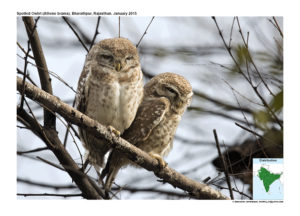
Spotted Owlet Athene brama
Etymology:
- Athena : Greek Mythology Athene, goddess of wisdom, war,and the liberal arts, whose favourite bird was the owl, an ancient association from her primitive role as goddess of the night
- Brama: Hindu god Lord Bramha, god of creation
Vernacular Names: Sind: Chibiru, Hindi: Khakusat, Khusattia, ChittidarChugad, Pun: Chugal, Bi: Pencha, Ben: Kuturepencha, Ass: Fecha, Lepcha: Dang tang pum, Guj: Chibri, Chibari, Mar: Pingla,Ta: Pulliaandai, Te: Pagadigante, Kan: Haalakki
Distribution in India: Wide spread Resident in India
Description: Size of 19–21 cm, wt. of110–115 g. It is a small owl with rounded head, heavily spotted crown, darkish facial disc bordered with white; curved white eyebrows. It is greyish-brown above with scattered white spots; flight-feathers and wing-coverts are mottled or spotted white; short tail is narrowly and rather indistinctly banded, lacking conspicuous white tip. The breast is creamy-white with short dark grey to brownish bars; broad white gorget; tarsi is long and thin, with short feathers to base of toes; irides are golden-yellow; cere is greenish; bill is greenish-horn, it is yellower on culmen and toes on yellowish-green. The races found in India are race indica (North & Central India) , race ultra (Arunachal Pradesh and E Assam), Nominate in South India.
Habitat: It is found in open forest and semi-open country,desert and semi-desert.It is found from lowlands to 1600 m.
Food habits: It eats small insects,small roosting birds, mice, shrews, geckos and toads. It ingests the shells of gastropods to help grind food in the gizzard. It leaves roost 15 minutes after sunset. It hunts mainly from perch; occasionally hovers before swooping on prey; several individuals sometimes congregate at night while hunting insects near electric lights.
Breeding habits: They breed in Nov–Apr in India. The nest is in a tree cavity, chimney, under ceiling or roof, in loft or eaves, in “earth cuttings” within well walls and banks. They appropriate cavities from mynas, parakeets and rollers. They line nest with feathers of other species. The copulation occurs in twilight. They lay a clutch size of 2–3 eggs. The female incubates the eggs, sits tight when nest is approached. The incubation period is 28–32 days. The eggs hatch synchronously and both male and female feed nestlings. The fledging period is 32 days, young remain with adults for 3 weeks after fledging.